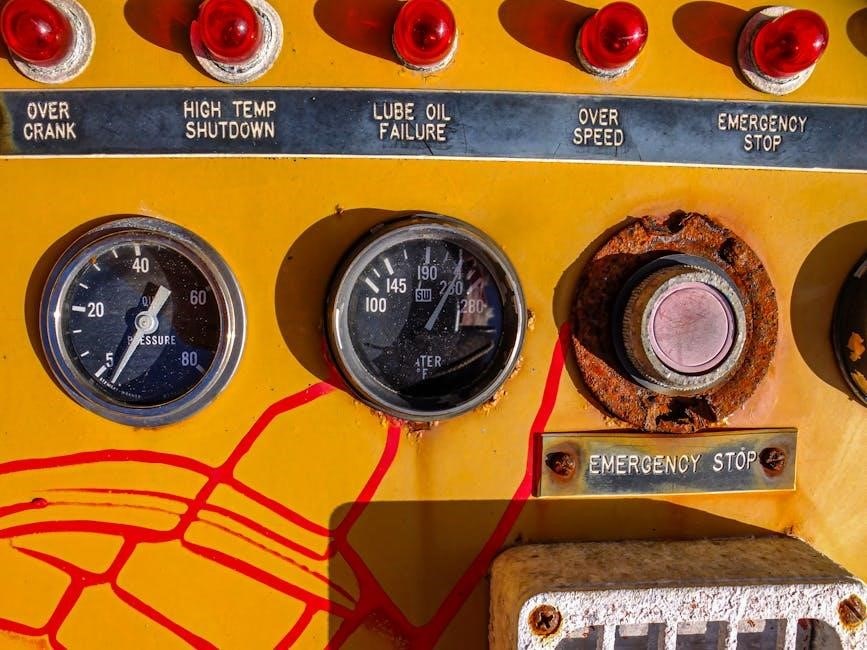kwikset smartcode 914 manual pdf
The Kwikset SmartCode 914 is a cutting-edge electronic deadbolt offering keyless entry, Z-Wave technology, and advanced security features. This manual provides detailed guidance for installation, programming, and troubleshooting, ensuring optimal functionality and security for your home.
Overview of the Kwikset SmartCode 914
The Kwikset SmartCode 914 is a state-of-the-art electronic deadbolt designed for residential security. It features a sleek, modern design with a capacitive touchpad for keyless entry and advanced Z-Wave technology for smart home integration. This lock offers enhanced security through its SmartKey re-keying system, allowing users to re-key the lock themselves. The SmartCode 914 also includes an auto-lock function and LED status indicators for added convenience and security. With its compatibility with various smart home systems, this lock provides seamless control and remote access capabilities. Its robust design and user-friendly interface make it a popular choice for homeowners seeking advanced security solutions. This manual will guide you through installation, programming, and troubleshooting to ensure optimal performance.
Importance of the Manual
This manual is essential for understanding and maximizing the functionality of the Kwikset SmartCode 914. It provides step-by-step instructions for installation, programming, and troubleshooting, ensuring proper setup and operation. The guide helps users navigate advanced features like Z-Wave integration, remote access, and security settings. By following the manual, homeowners can optimize their lock’s performance, enhance home security, and troubleshoot common issues efficiently. It serves as a comprehensive resource for both initial setup and ongoing maintenance, ensuring users fully utilize the lock’s capabilities. Whether you’re a new user or looking to refine your system, this manual is indispensable for achieving a seamless and secure smart home experience.

Features of the Kwikset SmartCode 914

The Kwikset SmartCode 914 offers a keyless entry system, Z-Wave technology, a touchpad interface, remote access capabilities, and LED status indicators. These features enhance security and convenience, providing seamless smart home integration and advanced locking functionality.
Keyless Entry System
The Kwikset SmartCode 914 features a convenient keyless entry system, allowing users to enter their home using a personalized code. This eliminates the need for physical keys, enhancing security and reducing the risk of key loss or theft. The system is designed for ease of use, with a touchpad interface that responds to code entry. Users can program multiple codes, ideal for granting access to family members, guests, or service providers. The keyless entry system also integrates with smart home technology, enabling remote monitoring and control through compatible hubs. This feature is particularly useful for homeowners seeking a modern, secure, and hassle-free locking solution.
Z-Wave Technology
The Kwikset SmartCode 914 utilizes Z-Wave technology to enable seamless integration with compatible smart home systems and security hubs. This wireless communication protocol allows for remote monitoring and control of the lock through a centralized system. By connecting to Z-Wave hubs, users can lock, unlock, and monitor their door’s status from anywhere using a smartphone or tablet. The technology also supports advanced features like real-time notifications and scene automation, enhancing home security and convenience. Z-Wave compatibility ensures the SmartCode 914 works with popular systems such as Samsung SmartThings, making it a versatile choice for modern smart homes. This integration capability makes the lock a valuable addition to any home automation setup.
Touchpad Interface
The Kwikset SmartCode 914 features an intuitive touchpad interface that simplifies keyless entry. The backlit keypad ensures visibility in low-light conditions, making it easy to enter codes day or night. The touchpad is designed for durability and responsiveness, providing reliable operation with minimal effort. Users can quickly input their codes, and the system offers feedback through visual and auditory cues. The interface is user-friendly, allowing homeowners to manage access effortlessly. Its sleek design complements various home styles, blending security with modern aesthetics. The touchpad’s responsiveness and backlighting enhance convenience, ensuring a seamless experience for all users. This feature is a cornerstone of the lock’s functionality, offering both security and ease of use.

Remote Access Capabilities
The Kwikset SmartCode 914 offers remote access capabilities through its Z-Wave technology, enabling users to control and monitor their lock from anywhere using a compatible smart home system. This feature allows homeowners to lock or unlock their door remotely via a smartphone or tablet, providing unparalleled convenience. Remote access also enables real-time notifications, alerting users to lock status changes or unauthorized access attempts. Compatible with systems like Samsung SmartThings, the SmartCode 914 integrates seamlessly into smart home ecosystems, enhancing security and accessibility. This feature is particularly useful for granting access to guests or service providers without physical keys. Remote management ensures peace of mind, knowing your home’s security can be managed from anywhere. This capability elevates the lock’s functionality, making it a versatile solution for modern living.
LED Status Indicators
The Kwikset SmartCode 914 features LED status indicators that provide visual feedback for various lock operations and statuses. The LED lights are designed to communicate important information, such as battery level, lock status, and programming confirmation. For instance, a red LED may indicate low battery, while a green LED signals successful locking or unlocking. Additionally, the LED may blink during programming or when the lock is in an abnormal state, such as being jammed. These indicators help users quickly understand the lock’s status without needing to consult the manual. The LED system enhances user experience by offering real-time feedback, ensuring smooth operation and peace of mind. This feature is particularly useful for troubleshooting and maintaining the lock’s functionality over time.
Installation Guide
The Kwikset SmartCode 914 installation guide provides a step-by-step process for proper setup, ensuring your lock functions securely and efficiently. Follow the manual’s instructions carefully.
Step-by-Step Installation Process
Begin by preparing your door according to the Kwikset SmartCode 914 manual. Ensure the door is properly aligned and the latch bolt is tapered for smooth operation. Next, attach the deadbolt to the door using the provided screws. Install the keypad on the exterior side, aligning it with the deadbolt. Connect the cable from the keypad to the lock body, ensuring secure fastening. Mount the interior assembly, making sure all wires are neatly routed. Finally, test the lock to confirm proper functionality. Refer to the manual for detailed diagrams and specific instructions to avoid installation errors.
Door Preparation Requirements
Before installing the Kwikset SmartCode 914, ensure your door meets specific preparation requirements. The door must have a thickness of 1.375 inches to 1.75 inches and a backset of 2.375 inches or 2.75 inches. A tapered latch bolt is essential for smooth operation. If your door does not have a tapered latch, consult the manual for adjustment instructions. Additionally, verify that the door is properly aligned and the strike plate is securely fastened. For precise drilling, refer to the SmartCode 914 drilling template available on the Kwikset website. Proper door preparation ensures a secure and functional installation of your electronic deadbolt.
Programming the SmartCode 914
Programming the Kwikset SmartCode 914 involves setting the master code and managing user codes for secure keyless entry. Follow the manual’s step-by-step guide for seamless configuration.
Setting the Master Code
Setting the master code on the Kwikset SmartCode 914 is essential for securing your lock and managing user access. The default master code is typically “00000000,” but it is highly recommended to change it for enhanced security. To set the master code, enter the current master code (default or existing) on the touchpad, followed by the “Program” button. Then, enter your new master code twice to confirm. This process ensures only authorized individuals can program or modify user codes. The master code should be unique and stored securely to prevent unauthorized access. Refer to the manual for detailed step-by-step instructions to ensure proper configuration and maintain the security of your smart lock.
Adding and Managing User Codes
Adding and managing user codes on the Kwikset SmartCode 914 is a straightforward process that enhances convenience and security. To add a user code, enter the master code, press the “Program” button, and then input the new user code twice. The system allows up to 30 unique user codes, making it ideal for granting access to family members, guests, or service providers. Codes can be temporary or permanent, depending on your needs. Managing codes involves editing or deleting existing ones, which can be done by accessing the programming menu using the master code. Regularly updating user codes ensures security and prevents unauthorized access. Refer to the manual for detailed instructions on managing codes effectively.

Smart Home Integration
The Kwikset SmartCode 914 seamlessly integrates with popular smart home systems like Samsung SmartThings and Crestron, offering remote control and enhanced automation through Z-Wave technology.
Compatible Smart Home Systems

The Kwikset SmartCode 914 is designed to integrate with various smart home systems, including Samsung SmartThings, Crestron, and Logitech Harmony. These systems enable remote lock control, voice commands, and seamless automation. Users can manage their locks through apps like SmartThings or Crestron Home, ensuring convenience and enhanced security. Compatibility with Z-Wave hubs allows for integration into existing smart home networks. For detailed configuration, refer to the Kwikset SmartCode 914 manual or visit their official website. This compatibility ensures the lock works harmoniously with other smart devices, offering a unified home automation experience. Proper setup guarantees reliable performance and advanced features like remote monitoring and custom scenes. Always follow the manual’s guidelines for optimal integration results.
Configuring Z-Wave Settings
Configuring Z-Wave settings for the Kwikset SmartCode 914 ensures seamless integration with compatible smart home systems. Start by enabling the Z-Wave mode on the lock, typically done through the master code or a specific button sequence. Use a Z-Wave controller or hub to initiate the inclusion process. The lock will enter pairing mode, indicated by LED flashes or beeps. Once connected, the lock can be controlled remotely and integrated into custom scenes. Refer to the Kwikset SmartCode 914 manual for detailed instructions. Ensure the lock is within range of the Z-Wave network for reliable performance. Proper configuration allows for advanced features like remote locking and status updates, enhancing your smart home experience. Always follow the manual’s guidelines for successful Z-Wave setup and integration.
Security Features
The Kwikset SmartCode 914 offers robust security with its keyless entry system, Z-Wave technology for remote monitoring, and SmartKey re-keying for enhanced protection against unauthorized access.
Auto-Lock Functionality

The Kwikset SmartCode 914 features an auto-lock functionality that automatically secures the door after a set period, ensuring your home remains protected even if you forget to lock it manually. This feature can be enabled or disabled based on your preferences, providing flexibility and convenience. The auto-lock timer can be adjusted according to your lifestyle, offering peace of mind whether you’re at home or away. This advanced security feature is designed to enhance your home’s safety without compromising ease of use. By automating the locking process, it reduces the risk of unauthorized access, making it a reliable addition to your smart home security system.
SmartKey Re-Keying Technology
The Kwikset SmartCode 914 incorporates SmartKey Re-Keying Technology, allowing homeowners to re-key the lock themselves in minutes without needing a locksmith. This innovative feature provides enhanced security and convenience, enabling users to reset the lock’s keyway to work with a new key if keys are lost or compromised. The process is straightforward, requiring only a few steps and a special tool included with the lock. This technology ensures that your home remains secure while offering flexibility and control over access. It’s a practical solution for maintaining security without the hassle and cost of professional re-keying services, making it a standout feature of the SmartCode 914 system.
Advanced Security Features
The Kwikset SmartCode 914 boasts advanced security features designed to protect your home. It includes BumpGuard technology, which prevents lock tampering through bumping, ensuring your door remains secure. The lock also features SmartKey security, resisting unauthorized key duplication and providing a high level of protection against potential breaches. Additionally, the system supports Z-Wave encryption, safeguarding wireless communications and preventing hacking attempts. The lock’s robust design and tamper-resistant components further enhance its security capabilities. These features work together to provide a reliable and secure locking solution, giving homeowners peace of mind. By integrating cutting-edge technology and proven security measures, the SmartCode 914 delivers exceptional protection for your home and family.

Troubleshooting Common Issues
Common issues with the Kwikset SmartCode 914 include keypad responsiveness and battery life. Consult the manual for solutions, such as cleaning the keypad or replacing batteries, to ensure optimal performance.
Identifying and Resolving Common Problems
Common issues with the Kwikset SmartCode 914 include keypad unresponsiveness, battery drain, and Z-Wave connectivity problems. To resolve these, clean the keypad with a soft cloth, replace batteries, and ensure proper Z-Wave pairing. If the lock fails to respond, check for correct installation and alignment. For persistent issues, reset the lock by removing and reinstalling the batteries. Refer to the manual for detailed troubleshooting steps. Regular firmware updates can also address software-related problems. Always ensure the lock is properly calibrated and configured for seamless operation. By following these steps, you can quickly identify and resolve common issues, ensuring your SmartCode 914 functions optimally.
Resetting the Lock
Resetting the Kwikset SmartCode 914 restores it to factory settings, erasing all user codes and settings. To reset, remove the batteries from the lock and press the lock button. Hold the # button on the keypad while reinstalling the batteries. Release the # button and press it again. The lock will beep, indicating the reset is complete. After resetting, reprogram the master code and user codes as needed. Note that resetting does not affect the Z-Wave settings if connected to a smart home system. Always refer to the manual for detailed instructions to ensure proper reset and reprogramming. This process ensures your lock operates securely and efficiently after any issues or system changes.

Maintenance and Care
Regular maintenance ensures optimal performance. Check and replace batteries, clean the exterior, and install firmware updates to keep your lock functioning securely and efficiently.
Battery Maintenance and Replacement
Proper battery care is essential for the Kwikset SmartCode 914’s performance. The lock uses 4 AA alkaline batteries, which typically last up to 12 months. Regularly check battery levels to avoid lockouts. Replace batteries when the LED indicator flashes red or the lock malfunctions. To replace, remove the interior cover, disconnect the battery pack, and install new batteries, ensuring correct polarity. Avoid mixing old and new batteries. Clean the terminals with a soft cloth to maintain connectivity. Store batteries in a cool, dry place to prolong life. Replace batteries promptly to ensure continuous security and functionality. Always test the lock after replacement to confirm proper operation.
Cleaning the Lock
Regular cleaning ensures the Kwikset SmartCode 914 maintains its appearance and functionality. Use a soft, dry cloth to wipe the exterior and touchpad, removing dirt and fingerprints. Avoid harsh chemicals, abrasive cleaners, or excessive moisture, as they may damage the finish or internal components. For stubborn stains, lightly dampen the cloth with water, but ensure no moisture seeps into the lock. Clean the touchpad regularly to prevent grime buildup, which could affect responsiveness. Avoid spraying cleaners directly on the lock. Instead, apply them to the cloth first. Regular maintenance helps preserve the lock’s durability and ensures smooth operation. Always refer to the manual for specific cleaning recommendations to maintain your warranty and lock performance.

Firmware Updates
Keeping your Kwikset SmartCode 914 firmware up to date is essential for optimal performance and security. Regular updates enhance functionality, improve compatibility with smart home systems, and address potential vulnerabilities. To update the firmware, ensure the lock is connected to your smart home hub or controller. Use the associated app or system interface to check for available updates. Follow the on-screen instructions to download and install the latest version. Never interrupt the update process, as this could cause system instability. After completion, test the lock to ensure all features operate correctly. Refer to the manual for specific guidance, as update procedures may vary depending on your connected system. Keeping the firmware current ensures your lock remains secure and functions seamlessly with your smart home setup.
Conclusion
The Kwikset SmartCode 914 excels in security and convenience, offering keyless entry and smart home integration. This manual has guided you through setup, features, and troubleshooting, ensuring optimal performance. Explore its advanced capabilities to enhance your home’s security and automation seamlessly.
Final Thoughts on the Kwikset SmartCode 914
The Kwikset SmartCode 914 stands out as a reliable and innovative smart lock, combining robust security with user-friendly features. Its keyless entry, Z-Wave integration, and advanced security measures make it an excellent choice for modern homes. The comprehensive manual ensures seamless installation and operation, while its compatibility with various smart home systems enhances convenience. With features like auto-lock and SmartKey re-keying, it offers both flexibility and peace of mind. Whether you’re prioritizing security, ease of use, or smart home integration, the SmartCode 914 delivers exceptional performance, making it a valuable addition to any home’s security setup.
Encouragement to Explore More Features
Take the time to explore the full potential of your Kwikset SmartCode 914. Its advanced features, such as remote access, custom user codes, and Z-Wave integration, offer unparalleled convenience and security. By diving into the manual, you’ll discover how to maximize these functionalities, ensuring your home is both smart and secure. Experiment with setting up unique access codes for family members or guests, and leverage the lock’s compatibility with smart home systems to create a seamless automation experience. Don’t hesitate to explore troubleshooting tips or firmware updates to keep your lock performing at its best. Visit the Kwikset website for additional resources and support to make the most of your SmartCode 914 investment.













































